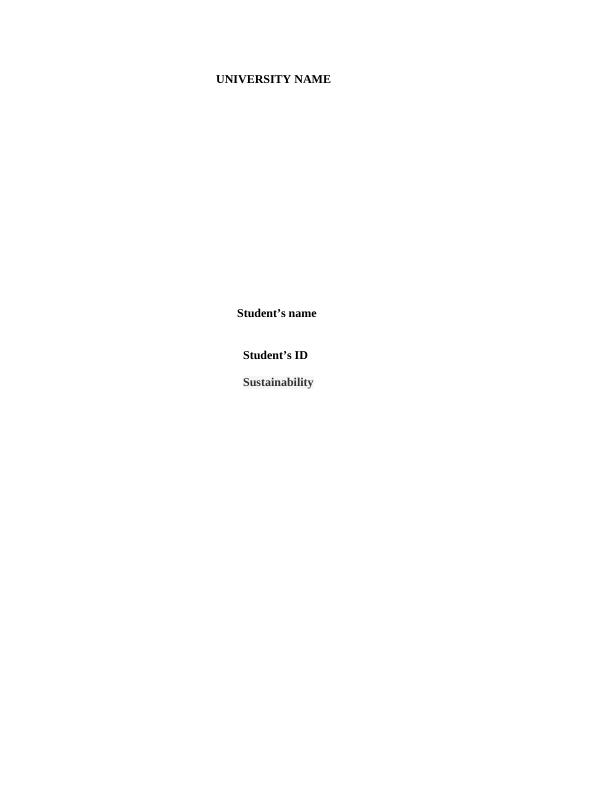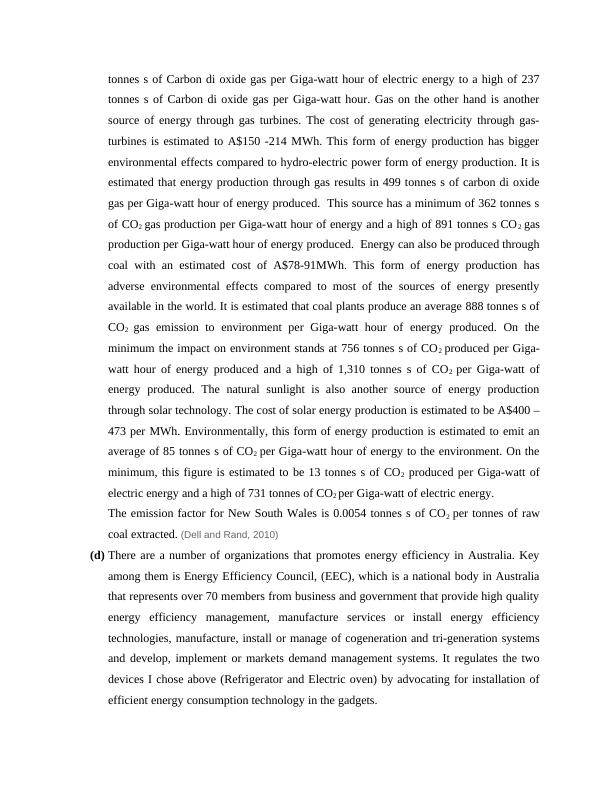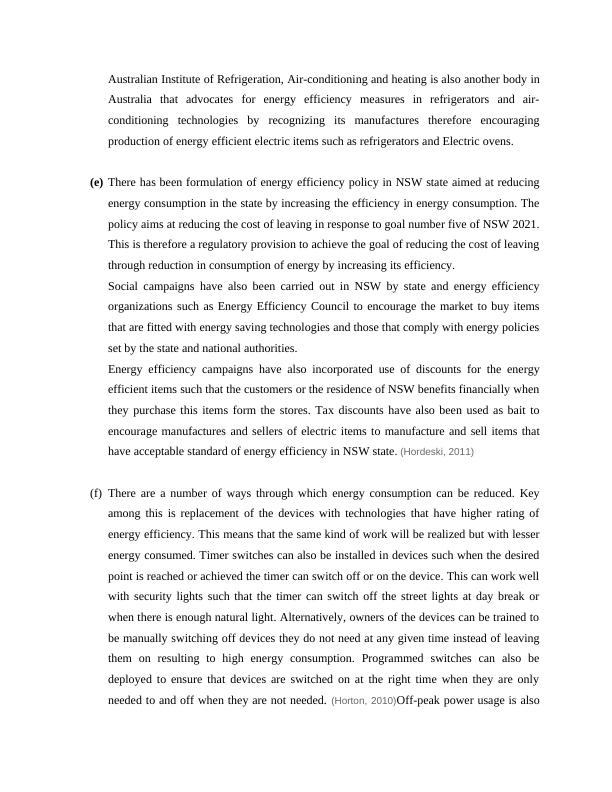Environmental Sustainability Assignment (Doc)
11 Pages3436 Words63 Views
Added on 2020-05-03
Environmental Sustainability Assignment (Doc)
Added on 2020-05-03
ShareRelated Documents
UNIVERSITY NAME Student’s name Student’s IDSustainability

Assignment No 3Question 1 Place considered; Home. (a) - Through electrical appliances such as Electric cooker/oven, lighting bulbs andElectronics.-Through Gas cooker/lighting -Through small machines such as mowers and farm machineries.(b)(i)Refrigerator (Samsung – 25.5 Cu. Ft. French Door with internal water dispenser)The energy use for the home refrigerator is 150 watts. This means that itconsumes 150 joules of electrical energy in one second or in terms of electrical is1 volt ampere. The alternative for this home appliance is natural refrigerationtechnology that uses charcoal placed in a perforated confinement and sealedoutside by a material with insulator properties such as wood or rubber. Thismachine has an efficiency of 98%. The fridge has a frequency of 50Hz with 230Voltage and its costs A$ 1,800. (Fix, 2008)(ii)Electric cooker/OvenThe energy consumption for the electrical cooker or oven at home is 1,000 watts. Thismeans that this particular appliance consumes 1,000 joules of electrical energy in onesecond. Put differently is 1,000 Volt Ampere. The alternative for this appliance is thegas cooker which uses gas as a source of energy. The efficiency for this homeappliance is at 98 % and operates at 50Hz frequency. It cost A$ 3,000. (Fix, 2008)(c)There are a number of sources of energy available across the world. One of these sourcesis electricity which can be produced through hydro process and lately through geothermalenergy contained underground. The cost of hydro-electric power generation is estimatedto be between A$200 – 250 MWH. Hydro-electric power generation is an expensiveprocess because of its infrastructure which requires maintenance more often. This form ofenergy production has one of the least environmental effects or impacts as it does nothave any tangible carbon emission to the environment a major source of environmentalpollution. This figure however is averagely estimated to be 26 tonnes s of carbon di oxideper Giga-watt hour of electric energy. In some instances, this figure can come down to 2

tonnes s of Carbon di oxide gas per Giga-watt hour of electric energy to a high of 237tonnes s of Carbon di oxide gas per Giga-watt hour. Gas on the other hand is anothersource of energy through gas turbines. The cost of generating electricity through gas-turbines is estimated to A$150 -214 MWh. This form of energy production has biggerenvironmental effects compared to hydro-electric power form of energy production. It isestimated that energy production through gas results in 499 tonnes s of carbon di oxidegas per Giga-watt hour of energy produced. This source has a minimum of 362 tonnes sof CO2 gas production per Giga-watt hour of energy and a high of 891 tonnes s CO2 gasproduction per Giga-watt hour of energy produced. Energy can also be produced throughcoal with an estimated cost of A$78-91MWh. This form of energy production hasadverse environmental effects compared to most of the sources of energy presentlyavailable in the world. It is estimated that coal plants produce an average 888 tonnes s ofCO2 gas emission to environment per Giga-watt hour of energy produced. On theminimum the impact on environment stands at 756 tonnes s of CO2 produced per Giga-watt hour of energy produced and a high of 1,310 tonnes s of CO2 per Giga-watt ofenergy produced. The natural sunlight is also another source of energy productionthrough solar technology. The cost of solar energy production is estimated to be A$400 –473 per MWh. Environmentally, this form of energy production is estimated to emit anaverage of 85 tonnes s of CO2 per Giga-watt hour of energy to the environment. On theminimum, this figure is estimated to be 13 tonnes s of CO2 produced per Giga-watt ofelectric energy and a high of 731 tonnes of CO2 per Giga-watt of electric energy. The emission factor for New South Wales is 0.0054 tonnes s of CO2 per tonnes of rawcoal extracted. (Dell and Rand, 2010)(d)There are a number of organizations that promotes energy efficiency in Australia. Keyamong them is Energy Efficiency Council, (EEC), which is a national body in Australiathat represents over 70 members from business and government that provide high qualityenergy efficiency management, manufacture services or install energy efficiencytechnologies, manufacture, install or manage of cogeneration and tri-generation systemsand develop, implement or markets demand management systems. It regulates the twodevices I chose above (Refrigerator and Electric oven) by advocating for installation ofefficient energy consumption technology in the gadgets.

Australian Institute of Refrigeration, Air-conditioning and heating is also another body inAustralia that advocates for energy efficiency measures in refrigerators and air-conditioning technologies by recognizing its manufactures therefore encouragingproduction of energy efficient electric items such as refrigerators and Electric ovens. (e)There has been formulation of energy efficiency policy in NSW state aimed at reducingenergy consumption in the state by increasing the efficiency in energy consumption. Thepolicy aims at reducing the cost of leaving in response to goal number five of NSW 2021.This is therefore a regulatory provision to achieve the goal of reducing the cost of leavingthrough reduction in consumption of energy by increasing its efficiency. Social campaigns have also been carried out in NSW by state and energy efficiencyorganizations such as Energy Efficiency Council to encourage the market to buy itemsthat are fitted with energy saving technologies and those that comply with energy policiesset by the state and national authorities. Energy efficiency campaigns have also incorporated use of discounts for the energyefficient items such that the customers or the residence of NSW benefits financially whenthey purchase this items form the stores. Tax discounts have also been used as bait toencourage manufactures and sellers of electric items to manufacture and sell items thathave acceptable standard of energy efficiency in NSW state. (Hordeski, 2011)(f)There are a number of ways through which energy consumption can be reduced. Keyamong this is replacement of the devices with technologies that have higher rating ofenergy efficiency. This means that the same kind of work will be realized but with lesserenergy consumed. Timer switches can also be installed in devices such when the desiredpoint is reached or achieved the timer can switch off or on the device. This can work wellwith security lights such that the timer can switch off the street lights at day break orwhen there is enough natural light. Alternatively, owners of the devices can be trained tobe manually switching off devices they do not need at any given time instead of leavingthem on resulting to high energy consumption. Programmed switches can also bedeployed to ensure that devices are switched on at the right time when they are onlyneeded to and off when they are not needed. (Horton, 2010)Off-peak power usage is also

End of preview
Want to access all the pages? Upload your documents or become a member.
